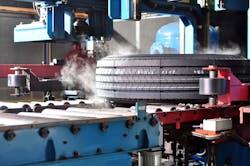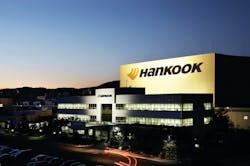A Step Ahead: Preventing Major Facility Interruption
Preventative maintenance is a must in any facility to ensure shortened downtime and to reduce impacts to production timelines. While there is a vast amount of preventative maintenance technologies on the market, one company decided they needed more than a simple system to detect equipment failures.
New Equipment Digest spoke with Hankook Tire about its development of a condition monitoring system that incorporates AI and IoT technologies to improve its production efficiency at a rapid rate, as well as to accelerate the advancement of smart factories.
New Equipment Digest (NED): What is the Hankook Condition Monitoring System Plus (CMS+) and what does it do?
Hankook Tire (HT): CMS+ is a facility abnormality prediction system based on artificial intelligence (AI) and the internet of things (IoT) developed by Hankook. It will help us double-check abnormalities efficiently, allowing us to accelerate the development of smart factories.
NED: What exactly is a facility abnormality prediction system? What is considered an abnormality?
HT: The system collects various data in real-time on vibration, noise, temperature, etc. to predict any abnormalities. CMS+ studies the normal range data and finds those that are outside of that “normal range,” by using Hankook’s massive data collection that has accumulated over time. The AI system also studies fault data, which uses a collection of data we have from malfunctions, to determine abnormalities when similar cases show up. Data collected is not from just one sensor. Different sensors in proximities collect data which then are incorporated together for analysis. The CMS+ system consistently studies all data to create this algorithm.
In detail: The CMS+ uses a 3-step AI algorithm which proceeds through the ‘Next-generation wireless-based IoT module,’ ‘Gateway,’ and ‘Server.’ This enables data analysis with precise predictions three to four times greater than the existing system. During the first step that uses the IoT module, CMS+ collects and analyzes data every second whereas the conventional method collected sensor data only at regular intervals. It was impossible to store the vast amounts of sensor data transmitted in real-time due to limitations in server capacity; however, the AI algorithm in next-generation wireless-based IoT module and gateway made it possible to automatically sort out and selectively store the data suspected of abnormalities.
This original AI algorithm was developed in cooperation with the Korea Advanced Institute of Science and Technology (KAIST). At the Gateway and Server level, CMS+ conducts an in-depth analysis of the data collected based on deep learning technology. It analyzes different types of data together including sensor data, temperature, and operational information to predict abnormal conditions of the facility in advance. It is also fitted with a real-time alarm system based on wireless communication technology. In the case of anomalies, the system immediately alarms the manager, which allows the manager to take appropriate action much faster.
NED: Does the introduction of AI and IoT remove the manual analysis of data by experts?
HK: No. While the system cuts down on having to sort through all the data, this step is not removed. The system will serve as an additional step for us to double-check, and the data will be collected for big data analysis, making data selection faster.
Hankook’s experts created the system and will still ultimately be the ones making the final call on any abnormalities. The system is serving to assist Hankook’s experts with their works. With over 4,000 sensors installed, the system analyzes the data to see if there are any immediate abnormalities, and then Hankook experts make the final call. Once our experts finish the data analysis, the AI system studies the algorithm set which will allow the system to make a similar analysis like that of our experts in the future.
NED: How is this technology different from similar prediction maintenance systems already on the market? Why did Hankook decide to develop its own?
HT: One may say that our system is similar to those already out in the market. However, most of those systems do not have the data that ours has accumulated over time, thus not having the expert management applied in the system yet. Hankook was not looking for a mere sensor data system—we needed a system that collects and analyzes quality data. We also needed it to have Hankook’s unique expertise, which was why we decided to develop the system ourselves. Yes, such technologies can be developed by IT or Algorithm companies but it will not be perfect. Data knowledge from all aspects needs to be accumulated and fused together. In Hankook Technology Group, we have experts in all areas such as manufacturing, IT, equipment, mechanics, etc. With help from the Korea Advanced Institute of Science and Technology (KAIST), we were able to create a system that best suited Hankook.
NED: Is this technology currently being used at all Hankook facilities?
HT: We’ve finished the tech development stage at the R&D level and finished a test run by installing the system at each stage. We are currently working on installing the system in all major equipment at the Geumsan Plant. We plan to apply this technology in all of our facilities eventually.
NED: How did Hankook implement the system into its factories? Did Hankook have to retrofit any existing equipment or acquire new equipment to make this work?
HT: Much of the equipment already had different sensors installed. We’ve changed the way data was collected and added the analysis system. Equipment was not retrofitted to accommodate the sensors, they were all created to accommodate each other. Universal sensors were purchased then applied on equipment then newly developed IoT modules are implemented nearby.
NED: How exactly has it helped Hankook’s productivity of production lines? What is the biggest change that has happened?
HT: CMS+, in short, predicts the possible abnormality, allowing us to fix the problem ahead of time, preventing possible utility malfunction. This saves time and energy as the maintenance needed can be executed with minimal loss in time. For example, we ran a test run with a utility that was up for maintenance and the system immediately found an equipment error, which was also confirmed by our experts. CMS+ will allow for double-checking of the system which will add reassurance in the analysis process and decrease the rate of doubts in oneself, helping our experts make efficient decisions on their reviews.
NED: What was the biggest challenge in developing this system?
HT: The algorithm sees a slight change as an abnormality, which could lead to resulting in a lot of data under suspicion. This was why it was important that Hankook experts’ knowledge is also combined into the system, so the abnormality found will be more accurate and in range with the actual data from the past.
About the Author
Laura Davis
Editor-in-Chief, New Equipment Digest
Laura Davis is the editor in chief of New Equipment Digest (NED), a brand part of the Manufacturing Group at EndeavorB2B. NED covers all products, equipment, solutions, and technology related to the broad scope of manufacturing, from mops and buckets to robots and automation. Laura has been a manufacturing product writer for eight years, knowledgeable about the ins and outs of the industry, along with what readers are looking for when wanting to learn about the latest products on the market.

